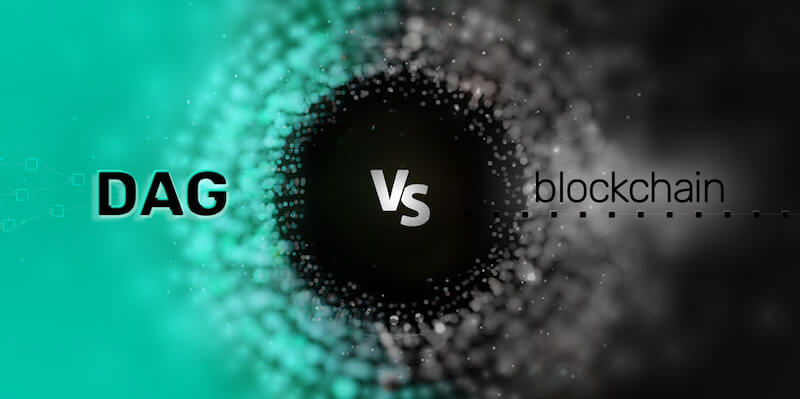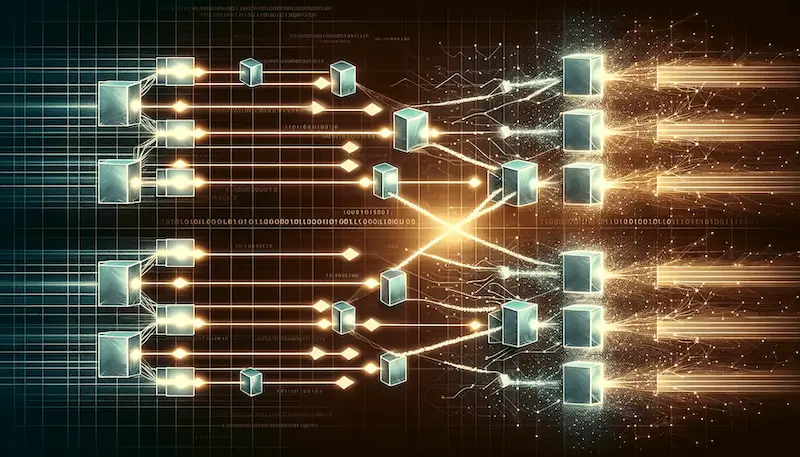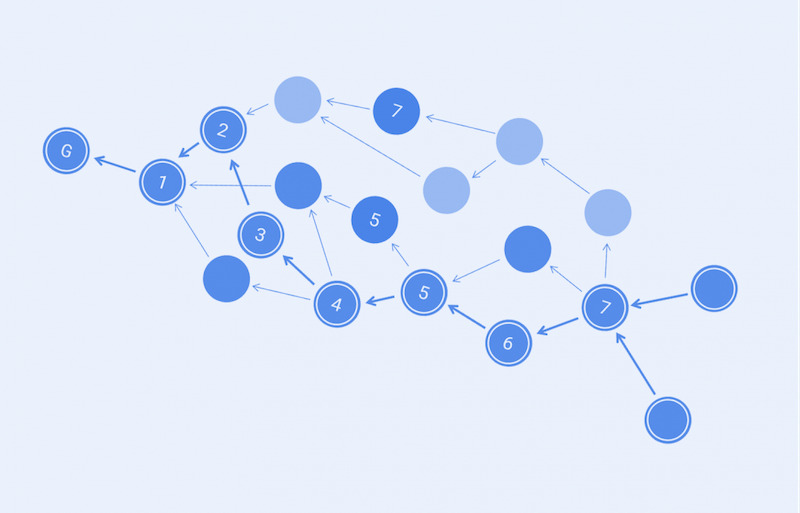Comparative DAG vs Blockchain: Peel back the layers, and what do you find at the cutting edge of tech? While many hail blockchain as the breakthrough, the rise of Directed Acyclic Graphs (DAG) is shaking things up. Let’s dive in and sift through the facts. What makes these two tick? How do they stand apart? And, which one will spearhead our digital destiny? Stay with me as we define the new digital backbone.
Understanding the Core Principles of DAG and Blockchain
Architectural Differences between DAG and Blockchain
DAG technology and blockchain are not the same. Think of blockchain as a line of blocks. Each block links to one before it. This forms a chain. It’s like a train, where each car hooks to the one in front. But DAG is different. It’s like a web. Many paths go from point A to B. So it can handle more trips at once.
In blockchain, miners add new blocks after checking transactions. This takes time and sometimes creates a line. Imagine waiting in line at a store. You can’t buy your snacks until it’s your turn. DAG doesn’t have a line. Every transaction confirms others. This is like teamwork. Everyone helps out and things go faster.
This is why DAG can work faster than blockchain. It doesn’t wait for blocks to verify things. Each time you do something in DAG, you help confirm other transactions. This makes things super swift. For example, IOTA’s Tangle is a type of DAG. It helps machines talk to each other fast, with no fees.
But with blockchain, you often have to pay to make transactions. Bitcoin uses blockchain. It rewards people who check transactions with new Bitcoin. This is called mining, and it’s a tough job. It uses lots of power and takes time.
Cryptographic Foundations of DAG and Blockchain Technologies
Now, let’s talk security. Both use crypto magic to keep safe. This is like making a secret code for your club. Only your pals know what the code means. In blockchain, each block has a secret code based on the one before. So if someone tries to mess with it, everyone will notice. That’s how Bitcoin keeps your money safe.
DAG has its own way of being safe. It doesn’t make a long chain of codes. Instead, each transaction makes its own secret code. This keeps it safe in a big web of transactions. The more it’s used, the safer it gets. That’s what’s cool about IOTA. Its design means as more devices use it, it’s tougher to break the codes.
In blockchain, your payment waits until miners finish a block. Think of this as baking cookies. You can’t eat them until they’re done. But with DAG, you don’t have to wait. Your transaction mixes with others right away. This is more like blending a smoothie. Add your fruits and blend; it’s ready in no time.
In sum, DAG and blockchain use different layouts to move and secure data. Blockchain is like a single file line. But DAG is a busy playground, where everyone plays a part. Both secure your stuff with secret codes. But how they build and protect the club’s fort differs. They each fit different needs. So think about what you’re looking for before you choose.
Performance and Scalability: A Comparative View
Transaction Speed and Efficiency in DAG vs. Blockchain
When we talk about DAG vs blockchain, speed is key. Look at Bitcoin. It handles about 5 transactions per second (tps). Then comes IOTA, a DAG crypto, with transactions that go through in seconds, not minutes. This is because IOTA uses Tangle, which doesn’t need blocks.
DAG networks shine with speed and low fees. Every user helps to confirm other transactions. More users mean faster transactions. This is why many see DAG as the future, especially for things like paying for your coffee or streaming movies.
How Scalability Challenges Are Addressed by DAG and Blockchain
Blockchains like Bitcoin struggle when more people use them. Because each block has limits, and miners take time. But, that’s where DAG stands out. Since DAG doesn’t use blocks or miners, it can handle many more users at once.
Blockchain tech moves slow because every transaction must fit into a block. And miners pick which transactions they confirm first. Often, those who pay more get in faster. But in DAG, every user helps. So, it’s like a team sport where everyone plays a part. It’s not a race with one winner.
Now, think about security. Blockchain uses proof of work to keep things safe. It’s like a math puzzle. DAG, though, has users check on each other. Different paths, same goal: keeping your digital dollars safe.
DAG is not all perfect though. It’s newer, and not as tested as blockchain. Some worry if it can really keep all the data safe when it gets big. It’s up to time to show us how it unfolds.
In the end, the tech that can handle more, do it faster, and use less energy could lead the pack. That’s why we keep an eye on both DAG and blockchain. They each have their own magic to show.
Let’s not forget smart contracts, too. Ethereum made them famous. They are like automatic contracts. If you do this, I’ll pay you that. Right now, blockchains are good for this. But DAG is also stepping up.
Everyone wants the fastest, cheapest way to do things. This battle between DAG and blockchain is not just tech talk. It’s about finding the smoothest path to tomorrow. We want our tech to be quick, cheap, and green. That’s the score we’re all keeping.
The future? Well, it might just belong to the best team player. And in this game, that’s looking a lot like DAG. But let’s watch and see. After all, the best part of a race is not knowing who’ll win, right?
Consensus Mechanisms and Network Operation
Innovative Approaches to Consensus in DAG Networks
Think of consensus like agreeing on what’s true in a network. Traditional ways take time and energy.
DAG changes this game by letting each user help verify others. It’s like a chain of trust. You know when someone says, “I’ve got your back”? That’s DAG. Each new entry vouches for the last one. With trust, nodes agree faster and cleaner than old-school chains.
So, DAG technology vs blockchain. What’s the upside? Speed, my friends, DAG’s quicker. It doesn’t wait its turn like blockchain. It’s a team sport—more players, more action.
Scalability of DAG and blockchain? DAG wins again. Picture a one-lane bridge versus a highway. DAG’s the highway, buzzing with cars. Speed and lots of them.
No mining needed here. DAG’s green, using less power than blockchain. Low energy, low fees. It’s like turning off lights when leaving a room. Smart, right?
Blockchain’s great for being firm on past dealings. Think of it as permanent ink. But DAG’s like a smart ink that adapts and grows with each word written, all in real-time.
Now, DAG doesn’t ditch all the old rules. It respects the codes—cryptographic principles in DAG stand firm. Safety’s not traded for speed.
Think IOTA’s Tangle. It’s like a web, not a queue. Opens up doors for nifty things like IoT, where gadgets talk without overloading the system.
Advantages of DAG over blockchain? You get the gist—faster, sleeker, and greener.
Traditional Consensus Algorithms Utilized in Blockchain
Traditional blockchains work on a “take turns” basis. Everyone follows the order, like kids in a game.
The king of these games is called Proof of Work. Miners solve puzzles to add new blocks. It’s proof they did the work. Trustworthy? Yes. But as slow as a snail mail in a digital world.
Enter Proof of Stake—a newer game. Here, it’s like a lottery. The more you have, the more you can win. But it’s not just luck; you must share the stake.
Bitcoin is the “big brother” of blockchain. It’s the first kid on the block, using Proof of Work. Remember waiting for dial-up internet? Same thing. Reliable, but time-consuming.
Blockchain in Bitcoin secures our money talks with hardcore math. No one can deny what’s written in its ledger. It’s there for keeps.
Blockchain decentralization means no one is the boss. Everyone keeps an eye, making sure things stay straight.
But blockchain can get crowded. Imagine everyone speaking at once. Gets loud and slow, doesn’t it?
Blockchain energy consumption is like old fridges. They keep things cold but run up the power bill. The world’s looking for smarter, like door alarms on fridges or DAG in tech.
Blockchain’s got its perks—solid like an oak tree. But it’s not a racecar. It’s steady. Good for some, not all.
In conclusion, know what you’re looking for. Fast and smart, or strong and steady?
That’s the tale of tech evolution, and it’s still getting written. Let’s stay tuned to see how it all plays out.
The Practical Implications and Applications
Analyzing DAG’s Potential Impact on the Internet of Things (IoT)
DAG technology is set to change the Internet of Things (IoT). How? It offers fast transactions and low fees. Unlike blockchains, DAGs don’t need miners. This is huge for IoT. Why? Because IoT devices often have less power and can’t handle mining. This makes DAGs a better match for IoT.
DAGs use a web-like structure. This lets IoT devices talk to each other quickly. They can even confirm their own transactions. Think of a smart home. Your fridge, oven, and lights could share data fast, thanks to a DAG network. No middle man needed.
Now, consider IOTA’s Tangle. It’s a type of DAG. It was made for IoT. In it, every user helps confirm transactions. So, more users make the network faster. That’s a big plus for IoT growth.
Blockchain Adoption Across Diverse Industry Use Cases
Blockchains are more than just for Bitcoin. They’re in many industries now. Each industry benefits in different ways. Like, healthcare uses blockchain for secure patient records. Finance uses it for quick, global transactions. Supply chains use blockchain to track products from start to finish.
Blockchain is great for these because it’s very secure. Each block in the chain confirms the last. This makes it hard to change past data. So, it’s good for keeping records safe. It also means folks can trust each other even if they don’t know each other. That’s key for businesses.
But blockchains do face challenges. They can be slow and costly sometimes. Mining also uses lots of energy. This is where blockchains can struggle, especially when compared to DAGs.
Comparing blockchain to DAG is important. Each has its strengths. Blockchains are top-notch for security and trust. DAGs shine in speed and low costs. For IoT, DAG seems the better choice. But blockchains have their place in industries that need rock-solid security. Understanding both can help us pick the right tool for the job. This knowledge can drive tech’s evolution in a big way.
In this post, we dove deep into DAG and blockchain, their designs and how they work. We looked at their building blocks and how they differ. We also examined how fast and well they scale when dealing with many users. We explored how each reaches agreement in the network and how this shapes their operation. Towards the end, we saw real-world uses, like DAG in IoT and blockchain in various industries.
For my final thought, it’s clear both DAG and blockchain hold great promise for the future. Every tech has its strengths. Some favor the swift, flexible style of DAG. Others trust the more established blockchain system. Always think about your needs when choosing. Stay informed, and pick wisely for the best results.
Q&A :
What is the difference between a DAG and a Blockchain?
DAG, which stands for Directed Acyclic Graph, is a data structure that allows for transactions to be recorded in a network without the strict linear sequence required by traditional blockchain. In contrast, a blockchain is a linked series of blocks that contain transaction data, whereby each block is dependent on the previous one in a linear, chronological order. DAGs aim to offer higher scalability and speed by allowing multiple chains of blocks to exist simultaneously and intertwine.
How does transaction speed compare between DAG and Blockchain?
Transaction speed is a major point of difference between DAGs and blockchains. Blockchains process transactions in blocks, which means they can face bottlenecks and delays as transaction volume grows. On the other hand, DAG technology allows for parallel processing of transactions, which can significantly increase speed and scalability. Unlike blockchain, DAG doesn’t require miners to validate every transaction, which can lead to faster confirmation times.
What are the main advantages of using DAG over traditional Blockchain?
DAG networks offer several advantages over traditional blockchains, such as improved scalability, as they can handle a higher number of transactions per second (TPS). They also offer decreased transaction fees, due to the absence of mining competition, and potentially increased security with the validation process dispersed across all network participants. Additionally, DAGs typically consume less energy than Proof-of-Work (PoW) blockchains, making them more environmentally friendly options.
Can DAGs replace Blockchains in the future?
While DAGs present certain advantages and innovations that could solve some of the limitations faced by blockchains, it’s unlikely they will completely replace blockchains in the future. Both technologies have their particular use cases and strengths. For example, blockchains are inherently secure due to their linear structure and accumulated proof of work, making them ideal for applications that prioritize security and immutability. DAGs may be better suited for high-speed and high-volume transactions environments.
Are DAG-based cryptocurrencies more efficient than Blockchain-based ones?
In terms of efficiency related to processing transactions, DAG-based cryptocurrencies generally offer higher throughput with the ability to process transactions in parallel, leading to quicker confirmation times. However, “efficiency” encapsulates more than just speed; it includes energy consumption, network robustness, and security. While DAGs can be more energetically efficient due to their non-reliant nature on miners and often have lower fees, the security and robustness aspects are routinely debated and can depend on the specific design and implementation of the DAG-based cryptocurrency.


